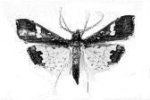Order: Lepidoptera (moth, butterfly)
Adult
Wings covered with scales and or dense hairs

Immature
Butterflies and moths undergo complete metamorphosis: egg, larva, pupa, and adult. The larvae, commonly known as caterpillars, have chewing mouthparts.
Noctuidae (cutworm moths). The Noctuidae is a large including species of economic importance like armyworms, cutworms, bollworms, and loopers. They are primarily foliage feeders, but many species also consume stems and fruits.
Pyralidae (snout and grass moths). The small moths of this family have a prominent snout (labial palps) and are commonly found in grassy areas, like the European corn borer.
Sphingidae (sphinx moths). The larvae of sphinx moths almost always have a spinelike projection on their eighth abdominal segment and, therefore, are commonly known as hornworms. These foliage feeders are a threat to many solanaceous crops.



| Picture | Scientific name | Common name | Description |
 | Agrotis segetum | Turnip moth | Larvae are covered with long hairs and 1st instars have 3, 2nd instars between 6 and 10 prolegs. Fully grown larvae are 40-50 in length. Adults have a wingspan of approx. 40 mm and brown fore wings with a clear circular spot in the middle. |
 | Agrotis ipsilon | Black cutworm | Larvae hide during daytime in the soil. Young larvae feed on leaves, older larvae feed commonly on seedlings at ground level, sometimes cutting off the stem. When disturbed larvae curl up into a C-shape. They are dark brown or black in color. Adults are brown or gray with irregular spots and lighter hind wings. |
 | Chrysodeixis eriosoma | Green semi looper | Young larvae feed on leave undersides making windows between the veins. Larval color varies depending from diet. They appear to have only 2 but have actually 3 prolegs. Adults have a bronze-white wings with two silvery white spots near the center of the forewings. |
 | Crocidolomia pavonana | Cabbage caterpillar | Young larvae feed on undersides of leaves, older larvae skeletonize complete leaves. Larvae are green-yellow in color, head and thorax are dark brown. Late instars are characterized by white longitudinal stripes. All abdominal segments have tubercles. |
 | Diaphania hyalinata | Melonworm | Larvae have white stripes on the length of the body. Adult moths have black wing margins with lighter, pearly-white areas. Wingspan is about 25 mm. |
 | Diaphania indica | Cucumber moth | The cucumber moth can be distinguished from the melonworm by the absence of an extension for the brown marking on the forewing. First instars are transparent but change to green. Fully grown larvae are up to 25 mm in length. Adult moth have transparent white wings with a brown band around the edge. |
 | Diaphania nitidalis | Pickleworm | The Pickleworm feeds on foliage and on fruits. Larvae are often colorless except for a black spot on each side of the head. The adult moth has a pale yellow spot near the center of each forewing. On the white-tipped abdomen are dark brush-like hairs. |
 | Helicoverpa armigera | Tomato fruitworm | 1st and 2nd larvae are yellow-white in color with dark legs. Color is extremely variable in older larvae. Adults have a wingspan of 35-40 cm, and a length of 14-18 mm. Damage differs by host species. The tomato fruitworm is polyphagous and older larvae may bore into pods and consume seeds. |
| - no photo available - | Spodoptera exigua | Beet armyworm | Young larvae commonly feed on the under surface of leaves, leaving the upper epidermis and larger veins intact. They are light green to dark brown with longitudinal stripes. Adults are 10-15 mm long with a wingspan of 25 mm. |
 | Spodoptera litura | Armyworm | Eggs are laid in clusters of several hundred. Larvae are hairless and variable in color. They have longitudinal bands and two dark spots laterally on each segment. |
 | Trichoplusia ni | Cabbage looper | Young larvae are initially white, but become later pale green. They have a light stripe down each side. They grow 4 cm in length. The caterpillar moves with a characteristic "looping" motion. Adults are 25 mm long, gray-brown with a wingspan of 33 to 38 mm. |
| Picture | Scientific name | Common name | Description |

![]()
![]()










